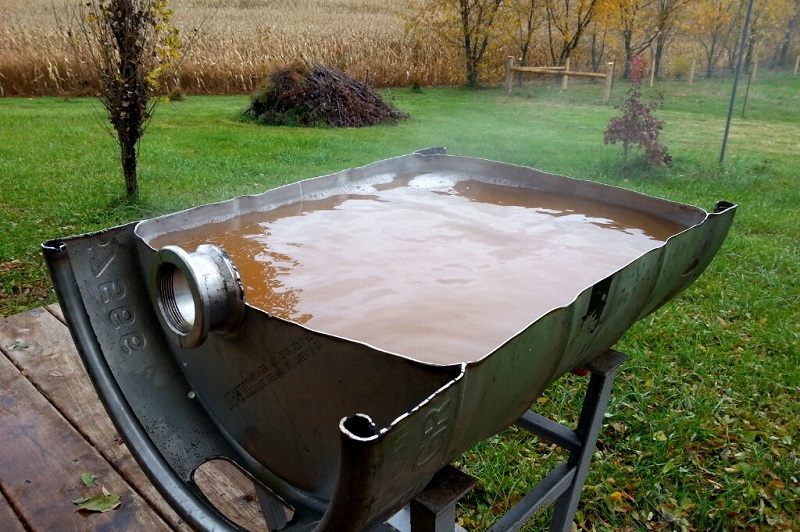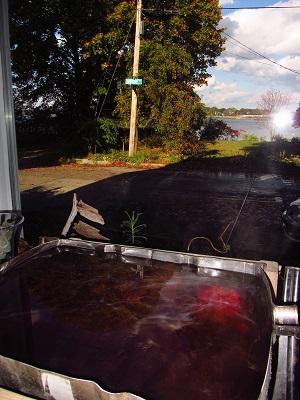Worth the Risk: Homebrewers Playing with Coolships

Coolships are open fermentation systems that collect ambient yeast and bacteria to ferment wort. This example was built by Jeremy Skorochid.
T.S. Eliot once said, “Only those who will risk going too far can possibly find out how far one can go.” Homebrewers are doing just that in their exploration of open fermentation.
Case in point is Johnnie Leroy Compton III, a homebrewer who goes the distance for his wild beers. After moving into a spacious 19th-century house in Liverpool, PA, he converted one of the rooms into a brewery and began using improvised coolships—open fermentation systems that collect ambient yeast and bacteria to ferment wort. Then, he experimented by adding dregs from his favorite sour ales alongside open fermentation.
Next, Compton expanded his experiments in wild yeast and bacteria fermentation by inoculating the whole brew room with these tiny beasts. After brewing several batches of beer with single cultures of Lactobacillus and Brettanomyces, Compton racked them into a pump-style garden sprayer and sprayed down the wood floor and moldings of his brewing space. He also likes to place fruit in his brewing room, further embellishing the natural flora of the space. Compton enjoys the layering of flavors he achieves with open fermentations and likens the process to becoming an artist, creating something unique for the palate.
Generally, homebrewers are meticulous about cleanliness, sanitation and fermentation conditions so that only their carefully selected variety of yeast will ferment the wort into a delicious beer with the expected aromas, flavors, clarity and alcohol level. Yet with the vast array of quality and predictable yeast available, some homebrewers are choosing to return to a simpler era—a time before microscopes, “smack packs” and stir plates. These throwback brewers are using open fermentation systems to collect ambient yeast and bacteria to ferment their wort. A coolship was the traditional way to cool beer before modern refrigeration. It typically consists of a large open shallow tray where the wort is transferred post-boil to cool naturally. Coolships (or koelschip, as they are known in Belgium) are still used in traditional Belgian sour breweries, such as Cantillon, and in a handful of American breweries as well.

Brian Hall’s coolship.
Brian Hall, a homebrewer in Portland, Maine, purchased a decommissioned keg from a defunct brewery and cut it in half to create a custom home coolship. He and others agree that using open coolships can be a risky business, especially in regions where they haven’t been in place for hundreds of years. The wort is being exposed to a profusion of local yeast and bacteria, which can behave in unpredictable ways. Yet Hall says the risk is worth it. He loves the romance of capturing the feel of a place through open fermentation.
“There is never going to be another beer like that,” he says of his successful coolship beers, which incidentally outnumber the failures. Hall only uses his coolship during the autumn and spring, when ambient bacteria and yeast are plentiful. And he’s not tied to only what he captures in the coolship—he occasionally will add dregs from his favorite bottles when he transfers to his fermenters.
“I like to give myself that advantage as well,” he says, noting that adding an established mixed culture can add additional depth to the finished beer. Hall uses glass carboys and wood barrels to finish fermenting his beers, often waiting over a year before his wild-fermented beers are ready to bottle. Hall says he’s “bringing back something that used to happen all the time” when he uses coolships and barrels, and that’s a very satisfying feeling.
Brooklyn resident Simon Tepas was inspired by the traditional Belgian brewing techniques described in Jeff Sparrow’s book, Wild Brews: Beer Beyond the Influence of Brewer’s Yeast (Brewers Publications). He uses small-batch open-bucket fermentations to get closer to nature. Tepas says he is interested in capturing the terroir of a place with his homebrew, explaining that “the sanitary environment necessary for producing clean beers is one technique, but this is another. Open fermentation brings geographical location and environment into your beer.” He’s particularly interested in exploring different brewing regions and is planning an open fermentation project to capture the terroir of new locations.
Noah Pearce of Ossining, NY, has a 200-gallon stainless-steel coolship currently in storage in New Hampshire. The coolship was passed down to him from his grandfather, who used it in his factory in Brooklyn’s Bushwick neighborhood. Pearce is planning on putting the coolship to use this spring with a group brew that will be run through the coolship before fermenting in a 54-gallon oak barrel. In the meantime, he is using a 5-gallon stainless-steel cat litter pan as an improvised coolship for smaller batches.
Pearce’s goal is “to make a beer that tastes like something I’ve never tasted before … and then share it.”


I have wanted to try this, but have some reservations, such as: what if a bird flies over and poops in my beer? Or a squirrel drops a “nugget” in there? How does one protect their previous beer from such unsanitary stuff? I live in Central Oregon, where LOTS of wild yeasts & such float around. I really want to try this!
Li’l help?
Ugh! Stoopid autocorrect! “precious” beer. Not previous…
Jeff Clough,
Despite those pictures of coolship in open air. The Belgians actually place their coolship in the attic and air flow through the shutters. The attic is also full of spider webs to keep flies away. You can always provide some shelter to keep birds dropping away as long there are air flowing around.
You should to try make clean beers with Cool Ship. Then do open fermentation. Then you should try making like Lagers or Ales.